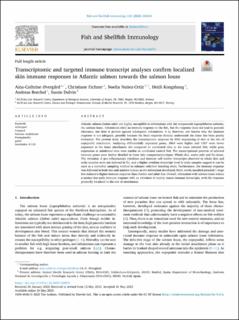Transcriptomic and targeted immune transcript analyses confirm localized skin immune responses in Atlantic salmon towards the salmon louse
Øvergård, Aina-Cathrine; Eichner, Christiane; Nuñez-Ortiz, Noelia; Kongshaug, Heidi; Borchel, Andreas; Dalvin, Sussie Trine
Journal article, Peer reviewed
Published version

Åpne
Permanent lenke
https://hdl.handle.net/11250/3083606Utgivelsesdato
2023Metadata
Vis full innførselSamlinger
- Department of Biological Sciences [2235]
- Registrations from Cristin [9791]
Sammendrag
Atlantic salmon (Salmo salar) are highly susceptible to infestations with the ectoparasite Lepeophtheirus salmonis, the salmon louse. Infestations elicit an immune response in the fish, but the response does not lead to parasite clearance, nor does it protect against subsequent infestations. It is, however, not known why the immune response is not adequate, possibly because the local response directly underneath the louse has been poorly evaluated. The present study describes the transcriptomic response by RNA sequencing of skin at the site of copepodid attachment. Analysing differentially expressed genes, 2864 were higher and 1357 were lower expressed at the louse attachment site compared to uninfested sites in the louse infested fish, while gene expression at uninfested sites were similar to uninfested control fish. The transcriptional patterns of selected immune genes were further detailed in three skin compartments/types: Whole skin, scales only and fin tissue. The elevation of pro-inflammatory cytokines and immune cell marker transcripts observed in whole skin and scale samples were not induced in fin, and a higher cytokine transcript level in scale samples suggest it can be used as a nonlethal sampling method to enhance selective breeding trials. Furthermore, the immune response was followed in both skin and anterior kidney as the infestation developed. Here, newly moulted preadult 1 stage lice induced a higher immune response than chalimi and adult lice. Overall, infestation with salmon louse induce a modest but early immune response with an elevation of mainly innate immune transcripts, with the response primarily localized to the site of attachment.
